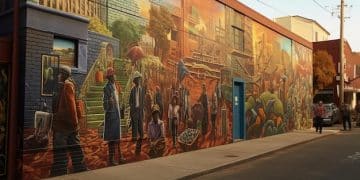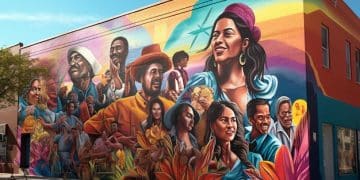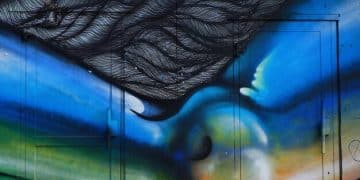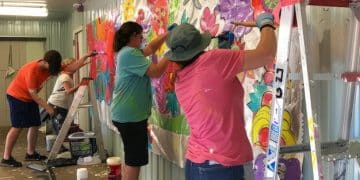Organize Legal Graffiti Art in Your US Community in 2025
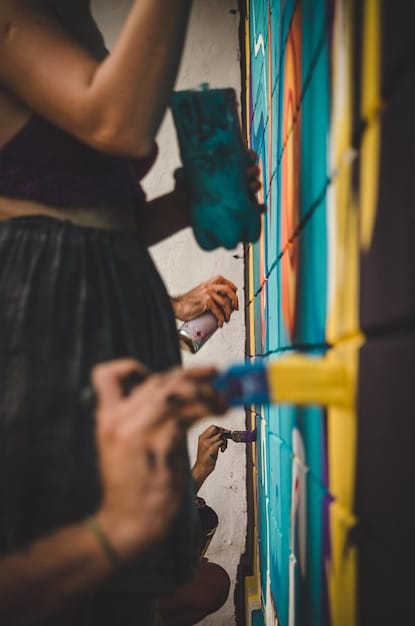
Organizing a legal graffiti art project in a US community in 2025 involves navigating local regulations, securing appropriate permissions, fostering community engagement, and collaborating with artists to transform public spaces into vibrant cultural assets, ensuring benefits for all stakeholders.
Embarking on a legal graffiti art project in your US community in 2025 can transform urban landscapes and foster civic pride. This guide delves into the detailed steps and considerations necessary to successfully launch and manage such an initiative, ensuring it benefits both artists and the broader public.
Understanding the Landscape: Regulations and Community Context
Before any brushes touch a wall, a thorough understanding of the local regulatory environment is paramount. Each US community, whether a bustling metropolis or a quaint town, likely has its own ordinances regarding public art, permits, and property usage. Ignoring these foundational elements can lead to legal entanglements and project failure, negating the positive impact you aim to achieve. Engagement with city officials early in the process is not merely a formality but a strategic move that can smooth the path forward.
Beyond legalities, grasping the community’s existing relationship with public art, and specifically graffiti, is crucial. Is there a history of successful murals, or has past unauthorized graffiti led to negative perceptions? These insights will inform how you frame your project and build support. A contextual understanding allows for tailored messaging and the anticipation of potential challenges, strengthening the project’s foundation.
Navigating Local Permitting Processes
Securing the necessary permits is often the most significant hurdle. This process typically involves identifying the relevant city department—often parks and recreation, cultural affairs, or urban planning. They will guide you through the specific requirements, which might include zoning clearances, public safety reviews, and aesthetic approvals. Prepare to present a detailed project plan, including proposed locations, artist biographies, and concept sketches, to demonstrate the project’s artistic merit and community benefit.
- Research your city’s public art commissions or cultural affairs offices.
- Identify specific permit applications for public space alterations.
- Prepare detailed project proposals outlining artistic vision and community benefits.
Assessing Community Receptiveness
Gauge local sentiment through community meetings, surveys, or informal conversations. Understand what residents value in their public spaces and how they perceive the integration of new art forms. A project that reflects community values and addresses local needs is far more likely to gain enthusiastic support and long-term success. This initial outreach can also help identify potential partners or vocal opponents whose concerns can be addressed proactively.
Consider starting with smaller-scale projects or pilot murals to build confidence and establish a positive track record. This incremental approach can help mitigate risks and demonstrate the value of legal graffiti art to hesitant community members. Successful pilot projects can then serve as powerful precedents for larger, more ambitious endeavors, making future approvals easier to obtain.
Building Alliances: Partnerships and Funding Strategies
A legal graffiti art project thrives on collaborative partnerships. Building a robust network of allies, from local businesses to non-profit organizations, can provide invaluable resources, amplify your reach, and demonstrate broad community support. These alliances extend beyond mere funding; they create a shared sense of ownership and investment in the project’s success. Identifying potential partners early in the planning phase allows for symbiotic relationships to develop organically, strengthening the entire initiative.
Funding is often the backbone of any ambitious project. Diversifying your funding streams reduces reliance on a single source and provides greater financial stability. Explore grants, corporate sponsorships, and individual donations, each requiring a tailored approach and compelling proposal. Articulating the project’s specific benefits to various stakeholders is key to securing financial backing.
Engaging Local Businesses and Corporations
Local businesses often seek opportunities to engage with the community and enhance their public image. Present your project as a unique chance for them to contribute to local culture, beautify shared spaces, and attract more foot traffic. Corporate social responsibility initiatives can align perfectly with artistic endeavors, providing a clear pathway for significant financial contributions or in-kind donations of materials. Highlight the visibility and positive association they will gain, turning their investment into a marketing asset.
- Identify businesses whose values align with community art.
- Propose clear benefits to their brand and customer engagement.
- Explore in-kind sponsorships for materials or operational support.
Leveraging Non-Profits and Community Organizations
Non-profit organizations dedicated to arts, culture, or youth development can offer considerable support through existing networks, volunteer pools, and grant-writing expertise. Partnering with them can open doors to specific funding opportunities and provide valuable administrative oversight. Their established trust within the community can also significantly boost the project’s credibility and public acceptance, making outreach efforts more effective.
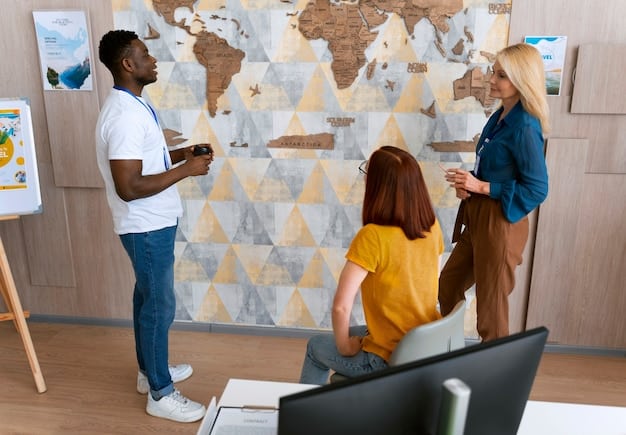
For example, a youth arts non-profit might already have relationships with schools, which could be ideal for talent scouting or educational outreach components of your project. These synergistic partnerships create a more robust and multifaceted project, capable of achieving broader impact and sustainability. Leveraging these existing structures avoids duplicating efforts and maximizes available resources, making the project more efficient.
Artist Selection and Project Design: Fostering Creativity and Relevance
The success of a legal graffiti art project hinges significantly on the artists involved and the deliberate design of the artwork itself. Selecting artists who not only possess exceptional talent but also understand the nuances of public art and community engagement is crucial. Their ability to translate public sentiment and project goals into compelling visual narratives will define the project’s impact. The design process demands a balance between artistic freedom and community relevance, ensuring the resulting pieces resonate broadly.
Consider the aesthetic impact of the art on passersby and local residents. Will it enhance the existing architecture or stand as a striking contrast? How will it age over time, and what maintenance will be required to preserve its vibrancy? These practical considerations should influence both artist selection and conceptual design. A well-designed project integrates seamlessly into its environment, becoming a cherished landmark rather than a temporary display.
Identifying and Vetting Artists
Seek artists with proven experience in mural work or large-scale public art, demonstrating an understanding of durable materials and techniques suitable for outdoor exposure. Portfolios should showcase not just technical skill but also a unique artistic voice that aligns with the project’s vision. Beyond artistic merit, assess their collaborative spirit and willingness to engage with the community, as public art is inherently a dialogue.
- Review portfolios for public art experience and thematic alignment.
- Conduct interviews to assess collaboration skills and vision.
- Prioritize artists with a strong connection to local culture or community.
Designing for Public Impact and Community Input
The design phase should be an iterative process involving community input. Workshops or public forums can solicit ideas, themes, and even specific imagery that reflects local identity and aspirations. While artists maintain creative control, incorporating community feedback ensures the art is truly “of the people, by the people,” fostering a deeper sense of ownership and pride. This collaborative approach ensures the art speaks to, and for, the community.
For instance, a mural could depict historical events, local flora and fauna, or abstract concepts inspired by the community’s spirit. The designs should aim for longevity, both artistically and physically, avoiding overly transient trends that might quickly become dated. Public art, especially legal graffiti, is a lasting statement, and its design should reflect that permanence and thoughtfulness. It should stand as a testament to the community’s vibrant narrative.
Logistics and Execution: From Wall Preparation to Unveiling
Once the artistic vision is solidified and funding secured, the practicalities of logistics and execution come to the forefront. This phase demands meticulous planning, coordination, and attention to detail, ensuring a smooth transition from concept to concrete reality. From selecting the right wall to managing suppliers and ensuring artist safety, every element requires careful consideration. A well-managed execution phase minimizes delays, controls costs, and ensures the art quality remains paramount. Anticipating logistical challenges can prevent costly mistakes and keep the project on track.
Consider the environmental factors that might affect the longevity of the art, such as sun exposure, humidity, or potential for vandalism. Choosing appropriate paints and sealants that can withstand these elements is a critical part of the logistical planning. Investing in high-quality materials from the outset will protect the visual integrity of the artwork for years to come, reducing future maintenance needs and preserving the community’s investment. This foresight contributes to the project’s long-term success and positive public perception.
Site Selection and Preparation
The chosen wall or surface must be structurally sound and capable of holding paint without excessive preparation. Factors like visibility, accessibility for artists and equipment, and surrounding pedestrian traffic should influence the final decision. Surface preparation, including cleaning, repairing, and priming, is vital for paint adhesion and durability. Neglecting proper preparation can lead to premature deterioration of the artwork, undermining the entire effort. Securing the site and ensuring artist safety is also a top priority, often involving fencing or traffic redirection.
- Assess wall integrity, visibility, and accessibility.
- Plan for thorough cleaning, repair, and priming of surfaces.
- Implement safety measures for artists and the public.
Managing Artists and Supplies
Effective project management ensures artists have the materials, equipment, and support they need to work efficiently. This includes coordinating paint orders, providing scaffolding or lifts, and ensuring access to water and power. Clear communication channels with artists are essential to address any challenges promptly and maintain morale. Regular check-ins and progress assessments help identify potential roadblocks before they escalate, maintaining the project’s momentum.
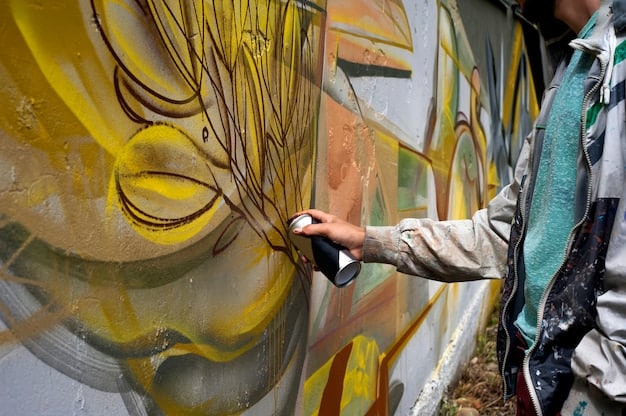
Moreover, consider the logistical aspects of waste management and cleanup. A legal graffiti art project should adhere to environmental best practices, responsibly disposing of paint cans and other materials. Planning for a comprehensive cleanup process post-completion is essential to leave the site pristine and reinforce the project’s positive impact on the community. This attention to detail reflects well on the organizers and artists involved, fostering goodwill.
Engaging the Community: Workshops, Events, and Education
A legal graffiti art project is more than just paint on a wall; it’s an opportunity for deep community engagement and cultural enrichment. Integrating educational workshops, public events, and interactive experiences transforms the project into a shared journey, fostering a deeper connection between the art, the artists, and the residents. This participatory approach cultivates a sense of ownership and appreciation, extending the project’s impact far beyond its visual appeal. Engagement strategies humanize the art, making it more accessible and relatable.
Consider the potential for collaboration with local schools or youth programs. Offering educational sessions about the history of graffiti, different artistic styles, or the process of creating public art can inspire the next generation of artists and art enthusiasts. These initiatives broaden the project’s educational footprint, providing lasting value to the community. Such activities also combat common misconceptions about graffiti, highlighting its artistic merit and cultural significance, promoting a more nuanced understanding among younger demographics.
Workshops and Interactive Sessions
Organize workshops where community members, particularly youth, can learn about graffiti art techniques, design principles, and artistic expression in a structured, legal environment. These hands-on experiences can demystify the art form, build skills, and provide a creative outlet. Interactive sessions with the artists, such as Q&A panels or live painting demonstrations, allow the public to witness the creative process firsthand and pose questions directly. These opportunities foster a sense of connection, breaking down barriers between artists and their audience, and creating memorable experiences.
- Host art workshops for various age groups, focusing on public art.
- Organize live painting events where the public can observe artists.
- Facilitate artist-led Q&A sessions to engage directly with diverse audiences.
Unveiling Events and Celebrations
Mark the completion of the project with a public unveiling or celebration. This event serves as an opportunity to acknowledge the artists, thank sponsors, and gather the community to admire the new artwork. Incorporate local music, food vendors, and family-friendly activities to create a festive atmosphere. A well-publicized unveiling generates excitement and pride, solidifying the project’s place within the community’s cultural fabric. These events become anchors of community memory, often fostering future artistic collaborations and encouraging ongoing engagement with public spaces.
The unveiling is also an opportune moment to share stories behind the art, explain thematic elements, and highlight the collaborative effort involved. Documenting the event through photography and videography ensures its legacy and provides valuable promotional material for future projects. This final celebration acts as a powerful collective affirmation, reinforcing the beauty and potential of legal graffiti art to transform and uplift public spaces. It is a moment of collective pride, bringing residents together under a banner of shared cultural achievement.
Legal and Ethical Considerations: Copyright, Maintenance, and Sustainability
Even in a legal graffiti art project, navigating copyright, ensuring proper maintenance, and planning for sustainability are critical. These considerations extend the project’s lifecycle beyond its creation, anticipating future challenges and protecting the artistic investment. Addressing these aspects proactively mitigates risks and ensures the art remains a positive asset for the community over time. A robust framework for these issues ensures the project’s legacy is secure and its benefits endure. Ignoring them can lead to disputes or premature deterioration of the artworks, diminishing the project’s long-term value.
The artwork, once completed, often becomes a public landmark, inviting interaction and contemplation. However, this public presence also necessitates thinking about its preservation. Factors such as weather, pollution, and even accidental damage can take their toll. Developing a long-term maintenance plan from the outset is as important as the initial painting process itself to ensure the art continues to inspire and uplift residents for decades to come. This careful planning demonstrates a commitment to the art’s continued contributions to the urban landscape.
Copyright and Artist Rights
Clarify ownership and usage rights of the artwork with the artists from the outset. While the art is public, the artist typically retains copyright. Agreements should specify whether the community can reproduce the image for promotional materials, merchandise, or future conservation efforts. Transparent contracts protect both the artists’ intellectual property and the community’s investment, avoiding potential disputes. Addressing these legalities upfront simplifies future interactions and fosters mutual trust.
- Draft clear contracts outlining artist copyright and usage rights.
- Define terms for replication and merchandising of the artwork.
- Consult legal counsel to ensure compliance with intellectual property laws.
Long-Term Maintenance and Conservation
Public art is exposed to the elements and potential vandalism, requiring ongoing maintenance. Develop a plan for regular cleaning, touch-ups, and repair. This might involve setting aside a maintenance fund, training community volunteers, or establishing a partnership with local conservators. Proactive conservation ensures the art remains vibrant and intact, safeguarding its aesthetic and cultural value for future generations. A well-maintained piece of art reflects positively on the community’s commitment to culture and its public spaces, showing a dedication to its artistic assets.
Consider the use of anti-graffiti coatings on murals to deter unauthorized additions and make cleaning easier. These protective layers can significantly extend the life of the artwork, reducing the frequency and cost of major interventions. Establishing a designated budget for annual maintenance is a forward-thinking approach that secures the longevity of the project and protects the initial investment. This financial foresight ensures the public art remains a source of pride rather than a burden.
Measuring Impact and Ensuring Sustainability: The Path Forward
The successful launch of a legal graffiti art project is not an endpoint but a new beginning. To ensure its long-term benefits and justify future endeavors, it’s imperative to measure its impact and strategize for sustainability. This involves assessing the project’s immediate effects on the community and building frameworks that allow the art to thrive and evolve over time. Continuously evaluating the project’s success through various metrics provides valuable insights for refinement and future planning, making each subsequent project more impactful and efficient.
Sustainability, in this context, refers not only to the physical longevity of the art but also to the continued positive engagement it fosters within the community. How can the project continue to generate interest, foster dialogue, and inspire new artistic expressions? Thinking beyond the initial creation can lead to innovative approaches such as incorporating the art into local tourism initiatives or educational curricula. A sustainable project embeds itself into the fabric of the community, becoming a lasting cultural asset.
Assessing Project Impact
Collect feedback from residents, artists, and stakeholders through surveys, interviews, and public forums to gauge the project’s impact on community aesthetics, civic pride, and crime rates. Document media coverage, social media engagement, and visitor attendance to quantify public interest. Beyond the visual appeal, assess whether the art has sparked meaningful conversations, inspired other community initiatives, or fostered a greater appreciation for public spaces. Quantitative data, combined with qualitative observations, paints a comprehensive picture of the project’s ripple effects, serving as powerful evidence of its value.
- Conduct surveys and interviews to gather qualitative feedback from residents.
- Monitor media coverage and social media engagement for public sentiment.
- Track foot traffic or visitor numbers to assess economic impact.
Strategies for Long-Term Sustainability
Develop a clear roadmap for the project’s future, considering ongoing maintenance, potential for new commissions, and pathways for community involvement. This could include establishing a dedicated fund for public art, creating a rotating artist program, or integrating the art into local walking tours. Building strong relationships with local government and cultural institutions will ensure continued support and resources. A project that demonstrates its value consistently will naturally attract sustained investment and community champions, solidifying its place as a permanent element of the urban landscape. This kind of forward-thinking strategy ensures the art continues to enrich the community for years to come.
Consider the possibility of creating an endowment or a “Friends of Public Art” group to ensure a perpetual source of funding for maintenance and future projects. These long-term planning mechanisms not only secure the existing art but also create a fertile ground for new artistic expressions to emerge. Empowering community members to take an active role in stewardship further enhances the project’s sustainability and reinforces its role as a communal asset, reflecting local pride and commitment. This symbiotic relationship transforms a temporary project into a permanent cultural legacy.
| Key Step | Brief Description |
|---|---|
| 📋 Understand Regulations | Research local laws, permits, and community sentiment towards public art. |
| 🤝 Build Partnerships | Engage businesses, non-profits, and secure diverse funding streams. |
| 🖌️ Select Artists & Design | Choose experienced artists and involve the community in design. |
| ✨ Ensure Sustainability | Plan for long-term maintenance, copyright, and community engagement to ensure longevity. |
Frequently Asked Questions About Organizing Legal Graffiti Art Projects
▼
The primary legal hurdles include obtaining city permits, zoning clearances, and potentially public safety approvals. Local ordinances vary significantly, so it’s crucial to research your specific community’s regulations. Early engagement with your city’s cultural affairs or urban planning departments is recommended to understand the requirements and navigate the application process effectively, avoiding potential legal complications later on.
▼
Funding can be secured through a variety of sources. Consider applying for public art grants from city or state arts councils, seeking corporate sponsorships from local businesses as part of their community initiatives, and engaging with non-profit organizations that support arts and culture. Crowdfunding and individual donations can also be effective, especially when the project resonates deeply with the community’s values and aspirations for public art.
▼
Community engagement is vital for a project’s success and long-term acceptance. Involving residents through workshops, public forums, and concept reviews ensures the art reflects local identity and values. This participation fosters a sense of ownership, transforms passive viewers into active participants, and builds stronger connections between the artists and the public. Strong community ties also generate broader support, which is often essential for gaining official approvals and securing necessary resources for the project.
▼
Selecting the right artists involves more than just talent. Look for artists with proven experience in large-scale murals and public art, demonstrating an understanding of durable materials and techniques. Assess their portfolio for a unique artistic voice that aligns with your project’s vision, and importantly, ensure they are collaborative and willing to engage with the community. Their ability to translate collective ideas into compelling visual narratives is critical for a truly impactful public artwork.
▼
Long-term considerations for artwork maintenance include establishing a plan for regular cleaning, minor touch-ups, and repair, accounting for environmental exposure and potential vandalism. Consider applying anti-graffiti coatings to deter unauthorized additions and facilitate easier cleaning. Allocating a dedicated maintenance fund or creating a volunteer program can ensure the artwork remains vibrant and preserved for future generations, securing its enduring cultural and aesthetic value to the community.
Conclusion
Organizing a legal graffiti art project in your US community in 2025 is a multifaceted endeavor that promises significant cultural and aesthetic rewards. From the initial deep dive into local regulations and the strategic formation of partnerships to the careful selection of artists and meticulous logistical planning, each step is critical. Beyond the practicalities, fostering genuine community engagement transforms a mere artistic display into a shared experience, cementing its place in the urban fabric. By prioritizing transparency, collaboration, and a long-term vision for maintenance and sustainability, these projects can transcend temporary beautification, becoming enduring symbols of community pride and artistic expression. The journey, while demanding, ultimately lays the groundwork for vibrant public spaces that resonate deeply with residents and visitors alike, proving that art, when embraced collectively, can truly transform our built environments.
